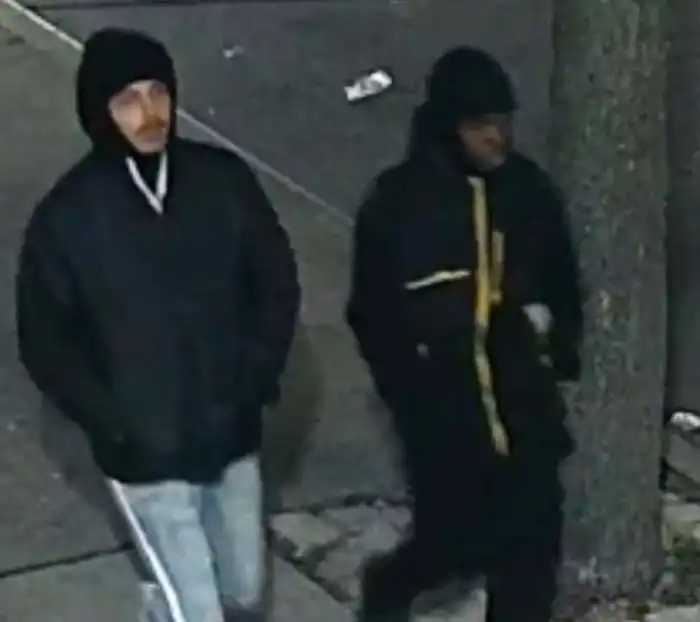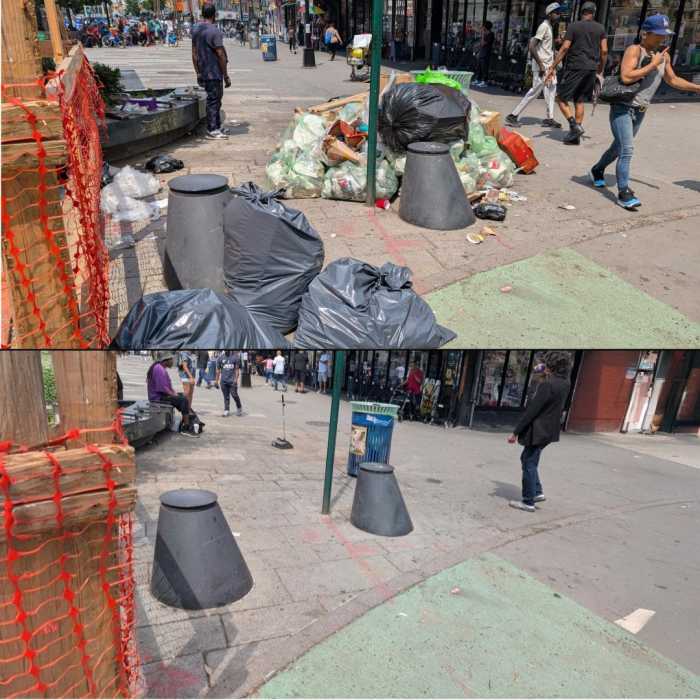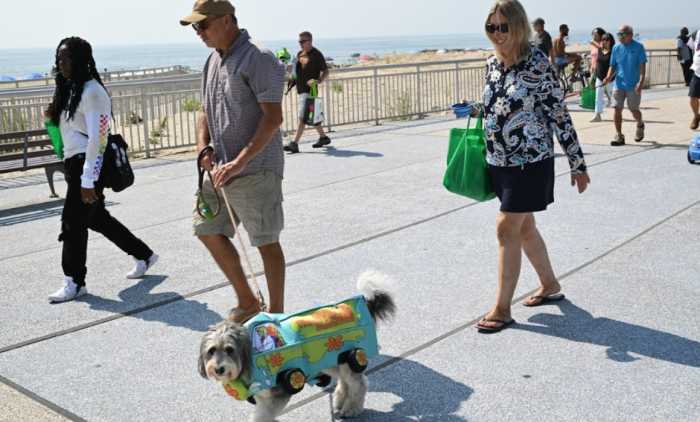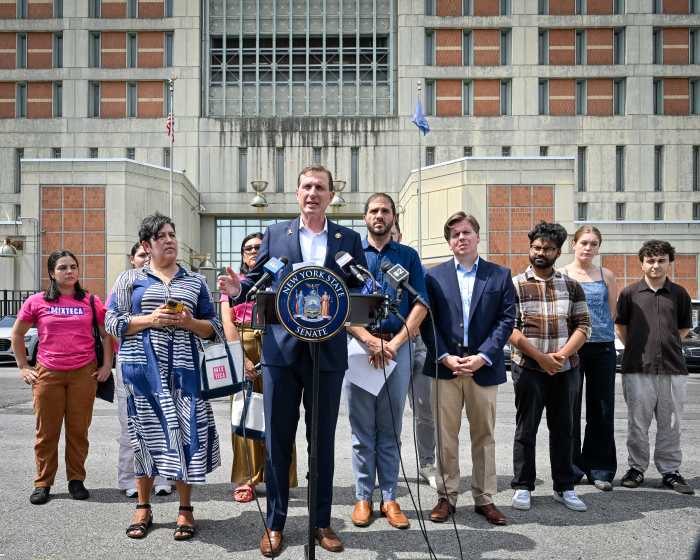By Jefferson Siegel
There is light at the end of the bike lane.
Last week, Community Board 4’s Transportation Committee voted to send to the full board a proposal for creating an Eighth Ave. bike lane from the Village to Midtown. The current Hudson St. bike lane comes to an abrupt end at 14th St., leaving bicyclists traveling northbound to merge alongside vehicular traffic.
The proposal, if approved by the full community board at its December meeting, would result in an extension of the lane north to 57th St., providing a bike path from the West Village through Midtown and Upper Manhattan to 169th Street and St. Nicholas Ave. There would be two unmarked sections along the route: from 39th to 42nd Sts., because of the two taxi lanes in front of the Port Authority Bus Terminal, and from 57th to 62nd Sts., due to the traffic merging patterns of Broadway and Eighth Ave. Those two gaps in the route would have signage to guide cyclists through those areas.
“We’re very excited. This has been a longtime priority for the community board,” said Jay Marcus, chairperson of the C.B. 4 Transportation Committee, speaking of the resolution. “We’re glad it’s finally happening.”
Joshua David, a Transportation Committee member, spoke enthusiastically about the 8-0 vote in favor of recommending the bike lane to the full board. “I thought it was a very positive step forward in a process that’s been going on for several years now,” he said.
Andrew Vesselinovitch, the city Department of Transportation’s bicycle program director, made one of several presentations at the Transportation Committee meeting last week. “When the community board hears the proposal, they know [D.O.T.] is fully behind it,” he said. “The whole thing will be done in 2006, pending the board’s approval.” Vesselinovitch said work can begin once the weather begins warming early next year and crews and materials are ready. Completion is expected in mid-2006.
Noah Budnick, projects director for Transportation Alternatives, an advocacy group that promotes bicycling, walking and public transit, also spoke at the meeting. “Eighth Ave. is part of the city’s Bike Master Plan,” Budnick explained. “So in the big picture, it’s part of the network that the city has mapped out.” Budnick said T.A. is looking forward to the lane’s completion because then, “it’s almost possible to do the entire length of Manhattan on a bike lane.”
The Eighth Ave. bike lane, first envisioned in the city’s 1997 Bicycle Master Plan, was formally proposed in a March 2003 letter from C.B. 4 to Margaret Forgione, D.O.T. Manhattan borough commissioner. The letter, penned by then-C.B. 4 Chairperson Simone Sindin, noted that “the creation of designated bicycle lanes will better enable cyclists to operate in a safe and law-abiding manner.” The letter went on to propose that, “it will help the board reduce traffic congestion and improve air quality within its district.”
The C.B. 4 Transportation Committee resolution elaborated on details for the lane. While the resolution recommends a 5-foot-wide bike lane, in addition it calls for a 2-to-3-foot-wide buffer. A similar buffer is already part of the Hudson St./Eighth Ave. lane leading up to 14th St.
Bike advocates and commuters consider the buffer a necessity for safer riding. Judy Ross commutes to and from work in Chelsea to her Upper West Side home. “The Hudson St. bike lane is perfect because it has a nice buffer,” she observed. “I would prefer no bike lane than an unsafe bike lane. If they’re going to do Eighth Ave., I encourage them to do it and make us safe,” Ross added.
T.A.’s Budnick said a buffer zone is a minimum requirement of the bike lane. “It really creates a prominent visual presence between the bike lane and moving traffic,” he observed. “The feedback that we get from cyclists is that the buffered lanes make them feel much safer, especially on big streets, and would encourage more people to ride.”
Some bike advocates have urged that physical barriers be erected to protect riders in bike lanes. Budnick would prefer a physical barrier on Eighth Ave. “Even with the city’s bike lanes, cyclists are still riding in the same right-of-way as moving traffic. A lot of people aren’t comfortable with that, especially kids and people who aren’t regular cyclists,” he said.
On one block in Herald Square on Sixth Ave., plastic bollards separate cars from the bike route. On Brooklyn’s Tillary St., a two-block-long path is lined with concrete barriers that shield cyclists on their ride to and from the Brooklyn Bridge. D.O.T.’s Vesselinovitch said physical barriers are unfeasible in most parts of the city.
“We would not want a barrier that a car couldn’t go through as long as we have parking on the other side of the bike lane,” Vesselinovitch said. “I wouldn’t recommend putting in plastic bollards, and certainly not a concrete barrier, if you’re expecting motor vehicles to cross through the bike lane to get to the parking,” he added.
Ian Dutton, a public member of the C.B. 2 Traffic and Transportation Committee and an airline pilot, has visited many European cities, which, he said, encourage safer and more viable alternatives to automobiles.
London, Berlin and Amsterdam, he said, “have a very significant [bicycle] infrastructure. In Berlin and in most German cities, the sidewalks are made to be wide enough so that there’s actually a lane on the sidewalk that will be a different color,” Dutton observed. “The bicyclists are actually on the sidewalk in a protected lane,” he added, noting a similarity with the bike and walking lanes along Hudson River Park.
“Amsterdam is actually legendary,” Dutton noted. “I think there are more bicycles in Amsterdam than there are residents. At the main train station they have a multilevel parking garage just for bicycles.”
At the C.B. 4 Transportation Committee meeting, Dutton welcomed the proposed Eighth Ave. lane but also encouraged D.O.T. to do more than “just painting white stripes and saying, it’s a bike lane now.” A buffer zone, he proposed, is “much more visible to the vehicles themselves. Cars think of white lines as things that they can just drive over at will, whereas a zone with stripes in it has more of an impact. It’s much more obvious that there’s a form of bicycle traffic that’s involved.”
Color-marked bike lanes were also suggested at the meeting. “D.O.T. has put in blue bike lanes on a few blocks in Brooklyn,” T.A.’s Budnick said.
“There are studies from other cities in the U.S. that have used colored bike lanes,” he noted. “In Portland, where they also do blue lanes, they found that motorists yielded to cyclists 20 percent more. They slowed or stopped when approaching the lanes 23 percent more. Three-quarters of cyclists and 50 percent of motorists said that the blue lanes felt safer,” he added. The studies also showed the blue lanes made busy and confusing intersections safer and more easily navigable.
In another show of support for bike lanes, Time’s Up!, the East Village-based bike advocacy group, held one of their periodic Bike Lane Liberation rides last Saturday. Members of the Clown Bicycle Brigade, dressed in their circus finest, assembled in Washington Square Park. After attaching red rubber noses, donning hats and adjusting wigs, the 12 riders formed a circle and read aloud from a constitution that sounded very similar to the pledge the comic book hero Green Lantern took to recharge the ring from which his powers sprang: “As cars eat precious fleeting gas, biking energy will always last.”
Then they offered their version of several familiar Beatles songs, including “All You Need Is Lanes” and, to the tune of “Don’t Let Me Down” they sang, “Don’t Block My Lanes.”
The group pedaled to Sixth Ave. and headed north to Midtown. Whenever they found the bike path blocked by a vehicle standing or parked in the lane, they stopped and affixed an orange-and-white “ticket,” bearing a strong similarity to a real summons, to the offending vehicle. The citation advised drivers that “Stopping, standing, parking or otherwise obstructing bike lanes is prohibited. Subject to a fine of up to $115.”
After leaving Midtown, they proceeded down Fifth Ave. By the time they stopped to ticket a truck near 13th St., they estimated they had issued 15 citations, including one to a Traffic Enforcement agent’s car parked in a Midtown bike lane.
On the city’s 16,000 miles of streets and roadways, there are 200 miles of bike lanes. In addition, another 20 to 30 miles have signage indicating a bicycle route. Two hundred more miles are car-free bike routes. The Bike Master Plan foresees a total of 900 miles of bike lanes throughout the city.
C.B. 4 will hold a final vote on the Eighth Ave. bike lane on Dec. 7. The meeting is scheduled for 6:30 p.m. at the Hudson Guild Auditorium at the Fulton Center, 119 Ninth Ave., between 17th and18th Sts.





























